Advances in
eISSN: 2373-6402


Research Article Volume 9 Issue 2
1Nepal Earthquake Recovery Program, Caritas Nepal, Nepal
2Department of Soil Science and Agri Engineering, Agriculture and Forestry University, Nepal
3Department of Agronomy, Agriculture and Forestry University, Nepal
Correspondence: Bibek Thapa, Nepal Earthquake Recovery Program, Caritas Nepal, Bhanimandal, Lalitpur, Nepal, Tel +9779851076800
Received: February 16, 2019 | Published: April 1, 2019
Citation: Thapa B, Khanal BR, Marahatta S. Effect of conservation agriculture on yield and yield attributing properties of wheat. Adv Plants Agric Res.2019;9(2):329-335. DOI: 10.15406/apar.2019.09.00444
Background: A field experiment was conducted to evaluate the effect of tillage practices, residue management and cropping system on wheat production at NMRP, Rampur, Chitwan from November 2015 to April 2016. The experiment was laid on Strip split design with combination of 12 different treatments i.e, zero tillage & conventional tillage as main plot in the strip, residue retention & residue removal as sub-plot factor and maize – wheat, maize + soybean – wheat & soybean – wheat cropping system as sub-sub plot factor. Three replications of the treatments were made. Plot retained with residue had significantly higher effect on, leaf area index (3.01), dry matter, thousand grain weight (43.61gm), grain yield (4000.22 kg ha-1), straw yield (4340.59 kg ha-1) and in harvest index (47.92) of wheat. Cropping system following soybean – wheat system had high significant to other cropping system in terms of leaf area index (3.03), dry matter, thousand grain weight (43.82 gm), grain yield (4166.93 kg ha-1), straw yield (4508.13 kg ha-1) and in harvest index (47.99) of wheat. Most of the results form interactions showed, the plot retained with residues under zero tillage following the soybean – wheat cropping system had significantly higher effect on the wheat yield and yield attributes.
Keywords: conservation agriculture, zero tillage, crop residue, crop rotation, wheat
Wheat is a crop of global significance and serves as the staple food of largest population after rice.1 Wheat stands as staple food for about 40% of the world’s population.2 It is the most important cereal crop in the world agricultural economy as food for humans and accounts for the highest volume in international trade among all the crops. Wheat is major staple food crop followed by rice in Nepal and is of paramount importance for food security. Grown in terai hills and mountains, it is pre-dominant winter crop and is grown from November to May. It occupies third position in Nepal in terms of area cultivated, grain produced and consumption. It accounts 22% area of total cereal production (754243 ha) and 20% of the total cereal production produced in Nepal (1727346 tons) with productivity of 2.29 t ha-1.3 Delayed planting, poor irrigation, declining soil fertility and loss of soil organic matter, unavailability of improved seed, poor plant protection measures are the major attributes for decline in wheat production.4 According to Timisina, et al.,5 nearly 84% of total wheat cultivates is cropped under rice-wheat cropping system. Rice and wheat are both exhaustive feeds and they heavily deplete the soil nutrient in rice-wheat cropping system. Residue retention is important to avoid the mining effect of soil nutrients. So there is urgent need to manage the residues for sustainability and stability of the system. Therefore, conservation agriculture has now turn out to be crucial for wheat production.
Conservation agriculture is the practice of cultivation which comprises of minimum soil disturbance, crop diversification and retention of crop residues. Conservation agriculture focuses mainly on management of soil, water and agricultural resources for achieving economic, ecological and socially sustainable agricultural production.6 Conservation agriculture is the group of crop management practices promoted to increase crop yields and to reduce soil degradation and develop system which is more resilient to weather –induced stressesincluding those caused by climate change and climate variability. At present, the world’s focus is shifted to the conservation and sound tillage systems are an integral part of it. Therefore, various techniques of tillage are followed to enhance the soil and water conservation for increased production. Many research studies Harold & Edwards,7 Triplett & Van Doren8 Phillips, et al.9 Showed, that minimum tillage is very beneficial for the conservation of soil and water. Minimum tillage generally coincides with the retention of crop residues, and it can play major role in improving the sustainability of cropping. Crop residues act as a sink and source for the plant nutrients.10 Different crop residues have different capacity to serve as sink and source of nutrients for crop yield depends largely on climatic conditions, soil properties, crop characteristics and tillage. A study in Rampur, Nepal, showed the improvement in the properties of soil under zero-tillage, and retention of residue following the soybean – wheat cropping system.11
Layout and experiment design
The field layout was done in strip split plot design with altogether of 12 treatments and 3 replications. The treatment includes, types of tillage system as main plot (a. zero tillage & b. conventional tillage), residue retention as sub plot (a. residue kept & b. residue removed) and cropping system as sub-sub plot (a. maize, b. soybean & c. maize + soybean). The individual plot size was 6 m x4 m (24m2). There was 0.5 m space between two plots and the distance of 1 m was maintained at each replication. The row spacing was maintained at 20 cm with continuous sowing in the row consisting of 30 rows in each plot. There were three destructive rows for taking plant samples for growth analysis. Further, one row was kept as a guard row between net plot and destructive rows from both sides. Outermost two rows of both sides of each plot were used as guard row (Table 1).
S.N. |
Symbol |
Treatment detail |
1 |
CTRRM-W |
Conventional Tillage + Residue Removed + Maize-wheat |
2 |
CTRRMS-W |
Conventional Tillage + Residue Removed + Maize+ soybean-wheat |
3 |
CTRRS-W |
Conventional Tillage + Residue Removed + Soybean – wheat |
4 |
CTRKM-W |
Conventional Tillage + Residue Kept + Maize- wheat |
5 |
CTRKMS-W |
Conventional Tillage + Residue Kept + Maize + Soybean – wheat |
6 |
CTRKS-W |
Conventional Tillage + Residue Kept + Soybean – wheat |
7 |
NTRRM-W |
No Tillage + Residue Removed + Maize-wheat |
8 |
NTRRMS-W |
No Tillage + Residue Removed + Maize+ soybean-wheat |
9 |
NTRRS-W |
No Tillage + Residue Removed + Soybean – wheat |
10 |
NTRKM-W |
No Tillage + Residue Kept + Maize- wheat |
11 |
NTRKMS-W |
No Tillage + Residue Kept + Maize + Soybean – wheat |
12 |
NTRKS-W |
No Tillage + Residue Kept + Soybean – wheat |
Table 1 Details of the treatments detail in a single replication with symbol
Field management practices
The wheat variety Vijay was used as test crop for the research purpose, and the standard seed rate of 120 kg ha-1 was used. In conventional tillage strip, the field was plowed twice using the tractor drawn cultivator, double passing each time up to depth of 20 cm. Seed and basal fertilizers were separately applied in rows manually in the conventional tillage strip. In zero tillage strip, the field was sprayed with glyphosate 47% SL before 10 days of sowing with the rate of 10 ml per liter. Wheat seed and fertilizer was drilled at depth of 3 cm by a using tractor drawn inclined plate zero-till drill. All the plots were fertilized using same level of nitrogen, phosphorous, and potassium. Nitrogen (N) was applied @ 100 kg ha-1, Phosphorus (P2O5) @ 50 kg ha-1and potassium (K2O) @ 50 kg ha-1 was applied in rows. Half dose of Phosphorous and potassium and only half dose of the nitrogen was applied at the time of sowing. Remaining nitrogen was applied in two equal splits as top dressings
Plant height
Plant height was observed to be non-significant in-between zero tillage and conventional tillage. No significant difference in plant height was observed in between residue management and in different cropping system. However, plant height was observed to be tallest in conventional tillage in both the recordings (59.77 cm at 65 DAS and 90.97 cm at 90 DAS) while the least height was observed in no tillage plot (52.28 cm at 65 DAS and 86.58 cm at 90 DAS). No any other interaction effects were observed in between different treatments. However, plant height at both the 65 DAS and 95 DAS appeared to be slightly higher in conventional tillage. This could have been as a result taken by the seed to germinate in no tilled plot in comparison to conventionally tilled plot. Karki & Shrestha,12 reported short plant height under no tillage in comparison to conventional tillage. Grand mean of plant height was observed to be 56.22 at 65 DAS and 88.50 at 90 DAS (Table 2).
Treatments |
Plant height (cm) |
|
65 DAS |
95 DAS |
|
Tillage Methods |
||
Conventional Tillage |
59.77 |
90.97 |
No Tillage |
52.28 |
86.58 |
SEm (±) |
1.27 |
1.67 |
LSD (=0.05) |
ns |
ns |
Residue Managements |
||
Residue Removed |
57.76 |
88.18 |
Residue Kept |
54.68 |
88.83 |
SEm (±) |
1.76 |
0.62 |
LSD (=0.05) |
ns |
ns |
Cropping Systems |
||
Maize – Wheat |
54.66 |
88.43 |
Maize + Soybean – Wheat |
57.33 |
86.88 |
Soybean – Wheat |
56.67 |
90.20 |
SEm (±) |
1.51 |
1.09 |
LSD (=0.05) |
ns |
ns |
CV, % |
11.66 |
5.46 |
Grand Mean |
56.22 |
88.50 |
Table 2 Effects of tillage methods, residue management and cropping system on plant height of wheat at Rampur, Chitwan, Nepal during winter season of 2015/16
Number of tiller per plant
Number of tiller per plant in the experiment was found to be non-significant to all the treatments at both the readings of 65 DAS and 90 DAS. However, at 65 DAS, highest tiller count was observed to be in cropping system of soybean-wheat (4.53) and least tiller count was observed in maize + soybean - wheat cropping system. Like was, at 90 DAS, the highest tiller count was recorded in the plot with where the residue was kept (5.42) and the least tiller count was observed in the plot with no residues (5.25). Mean number of tiller was recorded to be 4.37 at 65 DAS, and 5.33 at 90 DAS. The similar result was obtained by Papu et al.,13 This result is in contrast to result of the experiment conducted by Ali et al.,14 who reported higher number of tiller in conventional tillage than in reduced tillage (Table 3).
Treatments |
Number of tillers per plant |
|
65 DAS |
95 DAS |
|
Tillage Methods |
||
Conventional Tillage |
4.33 |
5.29 |
No Tillage |
4.41 |
5.38 |
SEm (±) |
0.23 |
0.33 |
LSD (=0.05) |
ns |
ns |
Residue Managements |
||
Residue Removed |
4.24 |
5.25 |
Residue Kept |
4.49 |
5.42 |
SEm (±) |
0.34 |
0.13 |
LSD (=0.05) |
ns |
ns |
Cropping Systems |
||
Maize – Wheat |
4.38 |
5.40 |
Maize + Soybean – Wheat |
4.18 |
5.29 |
Soybean – Wheat |
4.53 |
5.31 |
SEm (±) |
0.23 |
0.26 |
LSD (=0.05) |
ns |
ns |
CV, % |
19.05 |
18.20 |
Grand Mean |
4.37 |
5.33 |
Table 3 Effects of tillage methods, residue management and cropping system on number of tiller of wheat at Rampur, Chitwan, Nepal during winter season of 2015/16
Leaf area index
Leaf Area Index at 90 DAS was significantly affected by all the treatments. LAI was recorded significantly different with highest being at conventional tilled plot (2.89) over no tilled plot (2.73). The LAI significantly differed in residue managed plot with highest being at residue kept plot (3.01) and least at plot where there was no retention of residue (2.63). Different cropping system also significantly influenced the LAI, with highest being at soybean-wheat cropping system (3.03) and the least being at maize-wheat cropping system (2.62). Kumar et al.,15 reported similar result with higher leaf area index in the conventional line sowing of wheat. Significant interactions of among all the treatments were observed for LAI (Figure 1). Under conventional tillage, residue management did not have significant influenced on LAI while under no tillage, residue kept treatment had significantly higher LAI than the residue removed (Figure 1A). For Maize – wheat and Maize + Soybean – wheat, both tillage methods resulted the statistically similar LAI but for soybean – wheat significantly higher LAI was recorded under conventional tillage (Figure 1B). Under residue removed plots, maize + soybean – wheat and soybean – wheat had similar LAI and significantly higher than maize – wheat while under residue kept plots maize – wheat and maize + soybean – wheat had statistically similar LAI but lower than soybean – wheat (Figure 1C). Three factor observation was seen, and for both the tillage and residue management, soybean-wheat cropping system had significant influence on LAI (Figure 1D) (Table 4).
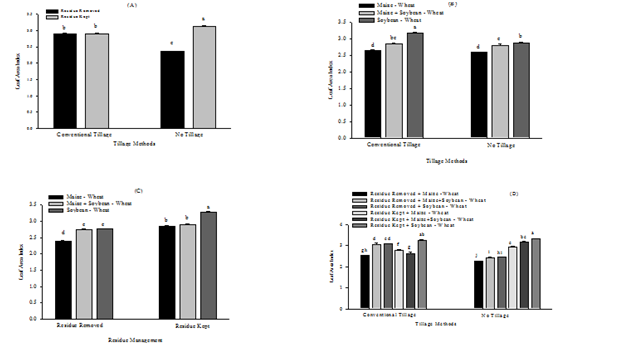
Figure 1 Leaf area index of wheat was influenced by interaction of (A) tillage methods and residue management, (B) tillage methods and cropping system, (C) residue management and cropping system, and (D) tillage methods, residue management and cropping system at Rampur, Chitwan, Nepal during winter season of 2015/16.
|
Treatments |
Leaf Area Index (90 DAS) |
|
Tillage Methods |
|
|
Conventional Tillage |
2.89a |
|
No Tillage |
2.73b |
|
SEm (±) |
0.02 |
|
LSD (=0.05) |
0.11 |
|
Residue management |
|
|
Residue Removed |
2.63b |
|
Residue Kept |
3.01a |
|
SEm (±) |
0.02 |
|
LSD (=0.05) |
0.14 |
|
Cropping System |
|
|
Maize – wheat |
2.62c |
|
Maize + soybean – wheat |
2.82b |
|
Soybean – wheat |
3.03a |
|
SEm (±) |
0.01 |
|
LSD (=0.05) |
0.04 |
|
CV, % |
12.51 |
|
Grand Mean |
2.82 |
Table 4 Effects of tillage methods, residue management and cropping system on number of LAI of wheat at Rampur, Chitwan, Nepal during winter season of 2015/16
Dry matter
Dry Matter was observed to be significantly different in all the treatments at 90 DAS. DM at different tillage methods was significantly different, with highest being at conventionally tilled plot (207.06) and least being at no tilled plot (192.18) (Table 5). Likewise, plot with residue retention had greater DM (212.94) in comparison with the plot with no retention of residue (187.89) which is significantly different to each other. Cropping system also, had significant effect on the DM of wheat. The plot with, soybean-wheat cropping system had highest DM (206.58) whereas the least DM was observed in maize-wheat cropping system (194.00). Similar result was observed by Ebelhar, et al,16 in their experiment. Interactive effects of tillage methods, residue management and cropping system on dry matter at 90 DAS of wheat is shown in Figure 2. Interaction effect was observed among all the treatments. Dry matter was significantly lower in the no till plot with combination of residue removal in comparison to rest of the residue management practices in both the tillage (Figure 2A). Dry matter in conventional tillage with soybean – wheat cropping system was significantly higher only to the no tilled plot with the maize-wheat cropping system (Figure 2B). Plot with retention of residue did not had any significant difference to each other whereas, it significantly differed to residue removed plot following maize-wheat cropping system (Figure 2C). In three factor interaction, for no tillage condition, plots with no retention of residues had significantly lower dry matter for any of the cropping system. However, no significant differences could be observed in the conventionally tilled plot (Figure 2D).


Figure 2 Dry Matter of wheat was influenced by interaction of (2A) tillage methods and residue management, (2B) tillage methods and cropping system, (2C) residue management and cropping system, and (2D) tillage methods, residue management and cropping system at Rampur, Chitwan, Nepal during winter season of 2015/16.
|
Treatments |
Dry Matter |
|
Tillage Methods |
|
|
Conventional Tillage |
207.06a |
|
No Tillage |
192.18b |
|
SEm (±) |
1.06 |
|
LSD (=0.05) |
6.42 |
|
Residue Managements |
|
|
Residue Removed |
187.89b |
|
Residue Kept |
212.94a |
|
SEm (±) |
1.20 |
|
LSD (=0.05) |
7.29 |
|
Cropping Systems |
|
|
Maize – Wheat |
194.00c |
|
Maize + Soybean – Wheat |
200.67b |
|
Soybean – Wheat |
206.58a |
|
SEm (±) |
1.07 |
|
LSD (=0.05) |
3.22 |
|
CV, % |
10.43 |
|
Grand Mean |
200.42 |
Table 5 Effects of tillage methods, residue management and cropping system on dry matter at 90 DAS of wheat at Rampur, Chitwan, Nepal during winter season of 2015/16
Yield Attributing Character
Among the different yield attributing characters, grain per spike and sterility percentage were found to be non-significant to all the treatments and interaction effects. However, highest grain per spike, was observed in the conventionally tilled plot (36.12) and the least was observed in no tilled plot (34.05). Sterility percentage was observed to be highest in with maize + soybean - wheat cropping system (25.13%) and least was observed in the plot with maize-wheat cropping system (23.63%). Significant effect on thousand grain weight was recorded in all the interactions of tillage and residue management with highest thousand grain weight being recorded in no till with retention of residue and the least in no till with removal of residue (Figure 3A). Similar result was observed in the interaction of residue management and cropping system with significantly higher thousand grain weight in plot managed with residue (retained) and following soybean – wheat cropping system (Figure 3B). Similar result was also observed in between all the interaction of treatments, with significantly higher thousand grain weight in no tilled plot retained with residue and following soybean – wheat cropping system (Figure 3C)
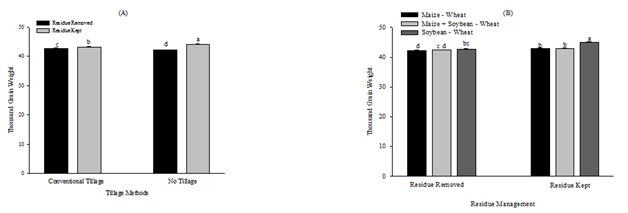
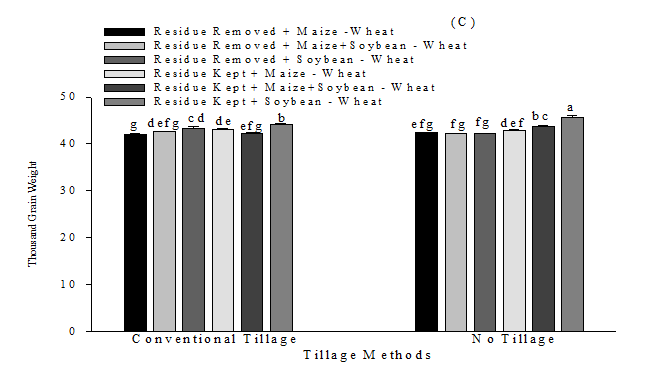
Figure 3 Thousand grain weight of wheat was influenced by interaction of (A) tillage methods and residue management, (B) residue management and cropping system, and (C) tillage methods, residue management and cropping system at Rampur, Chitwan, Nepal during winter season of 2015/16.
Likewise, there was no significant effect of tillage on thousand grain weight of wheat. But, TGW differed significantly on residue management and on different cropping system. Plot with residue retention had significantly higher TWG (43.61gm) compared to residue removed plots (42.46gm). Likewise, plot with soybean-wheat cropping system had significantly higher TGW (43.82gm) in comparison to plot following maize + soybean- wheat cropping system (42.71gm) and maize-wheat cropping system (42.58gm). The maize + soybean -wheat cropping system and maize-wheat cropping system were at par to each other.
Yield
Neither of grain yield, and straw yield were significant to the different tillage practices used. Similar result was observed by Bhattacharyya et al.,17 in the experiment conducted at the experimental field of the Vivekananda Institute of Hill Agriculture in India. However, significant effect of residue management and cropping system was observed in the straw yield, grain yield and harvest index of wheat. It was observed that, plot managed with residue had, significantly higher grain yield (4000.22Kg ha-1), higher straw yield (4340.59Kg ha-1) and higher harvest index (47.92) in comparisons to plot managed without residues. Likewise, cropping systems managed with soybean-wheat had significantly higher grain yield (4166.93Kg ha-1), higher straw yield (4508.13Kg ha-1) and higher harvest index (47.09). The significant effect was also seen between maize + soybean - wheat cropping system to maize-wheat cropping system in regard to grain yield, and straw yield. The higher yield in soybean – wheat cropping system in comparison to maize – wheat, cropping system is because of the higher C:N ratio in maize residue. Higher C:N ratio in maize residue makes slow decomposition of maize stubble. This effect immobilizes a relevant amount of N reducing its availability for wheat crop ultimately resulting in the yield loss. The other reason for the reduction of wheat yield in maize – wheat cropping system could be due to interferences during seeding. Bonggiovanni et al.,18 reported that when soybean is antecessor crop, there was more available nitrogen, which is also the reason for significantly higher wheat yield in soybean – wheat cropping system.
In interaction of tillage methods and residue management, no significant grain yield was resulted within conventional tillage method but were significantly higher than the plot with no tillage and removal of retention however, but significantly lower to plot managed with no till and adopting retention of residues (Figure 4A). In interaction between tillage and cropping system, soybean- wheat cropping system had significantly higher grain yield irrespective to tillage but conventionally tilled plot with soybean – wheat was found to have significantly higher grain yield (Figure 4B). In interaction between residue management and cropping system plot retained with residues and following soybean-maize interaction significantly higher grain yield than other plots. Higher significant difference in grain yield was observed within plot with either of residue management system but with different cropping system (Figure 4C). Interaction among every treatment in experiment showed that, highly significant different was observed within each treatment with highest yield in plot having no tillage, retaining residue and following soybean-maize cropping system (Figure 4D) (Table 6).
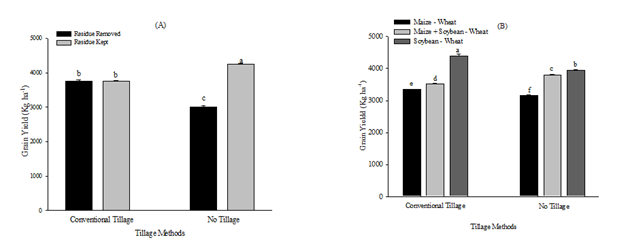
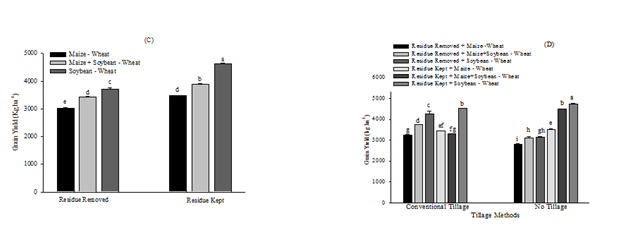
Figure 4 Grain yield of wheat was influenced by interaction of (A) tillage methods and residue management, (B) tillage methods and cropping system, (C) residue management and cropping system, and (D) tillage methods, residue management and cropping system at Rampur, Chitwan, Nepal during winter season of 2015/16.
|
Treatment |
Yield |
||
|
Grain Yield (Kg ha-1) |
Straw Yield (Kg ha-1) |
Harvest Index |
|
|
Tillage Methods Conventional Tillage |
3753.37 |
4093.88 |
47.80 |
|
No Tillage |
3580.44 |
3928.76 |
47.59 |
|
SEm (±) |
30.90 |
29.30 |
0.0337 |
|
LSD (=0.05) |
ns |
ns |
ns |
|
Residue Managements |
|||
|
Residue Removed |
3383.98b |
3731.99b |
47.50b |
|
Residue Kept |
4000.22a |
4340.59a |
47.92a |
|
SEm (±) |
6.40 |
7.50 |
0.02 |
|
LSD (=0.05) |
38.70 |
45.80 |
0.11 |
|
Cropping Systems |
|||
|
Maize – Wheat |
3253.98c |
3605.39c |
47.41c |
|
Maize + Soybean - Wheat |
3655.39b |
3995.36b |
47.74b |
|
Soybean – Wheat |
4166.93a |
4508.13a |
47.99a |
|
SEm (±) |
24.90 |
24.60 |
0.04 |
|
LSD (=0.05) |
74.70 |
73.80 |
0.12 |
|
CV, % |
16.90 |
15.34 |
0.88 |
|
Grand Mean |
3692.10 |
4036.29 |
47.71 |
Table 6 Effects of tillage methods, residue management and cropping system on yield of wheat at Rampur, Chitwan, Nepal during winter season of 2015/16
From the experiment, the following results were obtained
No significant effect of tillage was observed on effect tiller m-2, grain per spike, thousand grain weight, straw yield, and grain yield and harvest index. Whereas, conventional tillage had significantly higher effect on leaf area index and dry matter. Plot retained with residue and cropping system following soybean – wheat system had significantly higher effect on, lead area index, dry matter, thousand grain weight, grain yield, and straw yield of wheat. From the experiment, it can be concluded that, adoption of no tillage, with retention of residue following the soybean – wheat cropping system has significant positive effect on yield and yield attributing characters of wheat crop.
I would like to thank Dr. Tika Bahadur Karki, senior scientist, Nepal Agriculture Research Council for his tremendous support and encouragement to carry on with this research work in conservation agriculture. I am also very thankful to my wife Ms. Mamata Pandey for her support and faith in carrying out this research.
There is no any conflict of interest.

©2019 Thapa, et al. This is an open access article distributed under the terms of the, which permits unrestricted use, distribution, and build upon your work non-commercially.